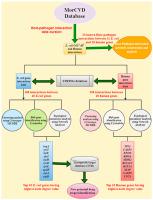Computers in Biology and Medicine ( IF 7.0 ) Pub Date : 2021-04-21 , DOI: 10.1016/j.compbiomed.2021.104417 Sravan Kumar Miryala 1 , Anand Anbarasu 1 , Sudha Ramaiah 1

|
Background
Cardiovascular Disease (CVD) is one of the most common causes of mortality in humans. Presently, the role of pathogens in the initiation and progression of the CVDs is not clearly understood. Hence, it is essential to understand the molecular-level interactions between the human proteins and the microbial proteins to deduce their functional roles in the CVDs.
Method
The host-pathogen interactions (HPI) related to CVDs in the case of E. coli str. O157:H7 colonization were curated, and also the protein-protein interactions (PPI) between humans and E. coli were collected. Gene interaction network (GIN) and functional enrichment analyses (FEA) were utilized for this.
Results
The GIN revealed dense interactions between the functional partners. The FEA indicated that the essential pathways played a significant role in humans as well as in E. coil. The primary responses against most of the bacterial pathogens in humans are different from that of E. coli; Terpenoid biosynthesis and production of secondary metabolite pathways aid the survival of the E. coli inside the host. Interestingly, network analysis divulged that the E. coli genes ksgA, rpsT, ispE, rpsI, ispH, and the human genes TP53, CASP3, CYCS, EP300, RHOA communicated by significant numbers in direct interactions.
Conclusions
The results obtained from the present study will help the researchers understand the molecular-level interactions in the CVDs between the human and the E. coli genes. The important genes with vital interactions can be considered as hub molecules and can be exploited for the new drug discovery.
中文翻译:

基因相互作用网络揭示肠道细菌在心血管疾病中的作用:大肠杆菌O157:H7宿主-细菌相互作用研究
背景
心血管疾病(CVD)是人类最常见的死亡原因之一。目前,尚不清楚病原体在CVD的发生和发展中的作用。因此,必须了解人类蛋白质与微生物蛋白质之间的分子水平相互作用,以推断其在CVD中的功能。
方法
在大肠杆菌链霉菌的情况下,与CVD相关的宿主-病原体相互作用(HPI)。策划了O157:H7的定殖,并收集了人与大肠杆菌之间的蛋白质-蛋白质相互作用(PPI)。为此,利用了基因相互作用网络(GIN)和功能富集分析(FEA)。
结果
GIN揭示了功能伙伴之间的紧密互动。FEA表明基本途径在人类和大肠杆菌中都起着重要作用。针对人类大多数细菌性病原体的主要反应不同于大肠杆菌。萜类化合物的生物合成和次级代谢产物途径的产生有助于宿主内大肠杆菌的存活。有趣的是,网络分析揭示了大肠杆菌基因ksgA,rpsT,ispE,rpsI,ispH和人类基因TP53,CASP3,CYCS,EP300,RHOA进行了大量直接交互作用。
结论
从本研究中获得的结果将有助于研究人员了解人与大肠杆菌基因之间在CVD中的分子水平相互作用。具有重要相互作用的重要基因可被视为中心分子,可用于新药开发。











































 京公网安备 11010802027423号
京公网安备 11010802027423号